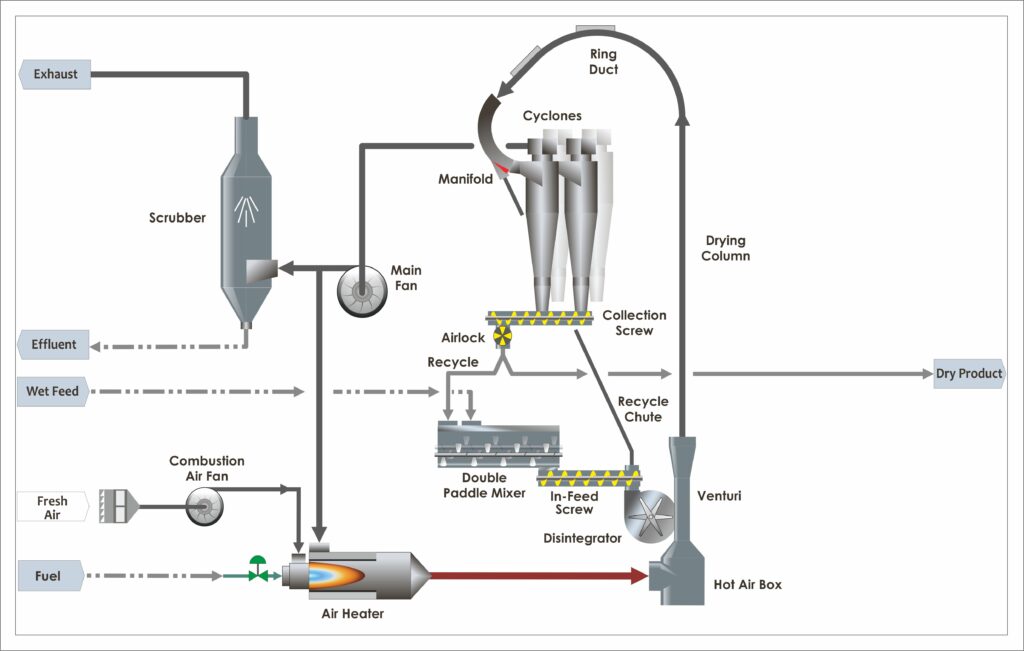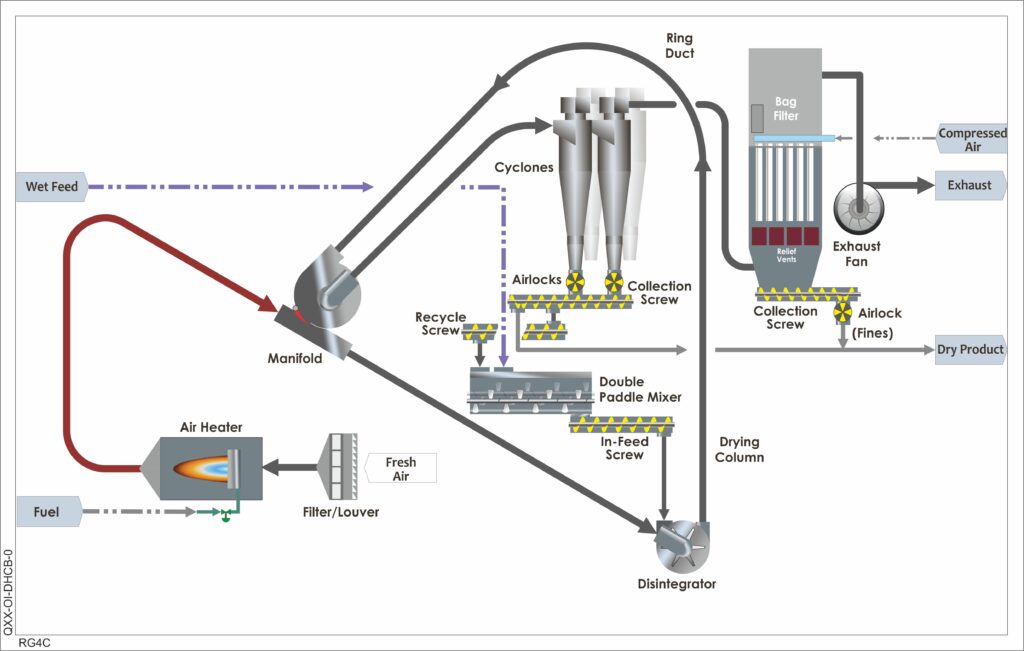Ring dryers, also known as pneumatic dryers, are a type of industrial drying equipment that dries a variety of materials. They have a unique feature that sets them apart from typical flash dryers: a "manifold classifier" positioned in the drying system. Industries, such as food, chemical, and pharmaceutical, use these dryers to remove moisture from wet materials by applying heat, causing the moisture to evaporate. Ring dryers are especially useful for materials that are sensitive to heat and cannot tolerate extended periods of high temperatures. Additionally, they are ideal for materials that are sticky, viscous, or have high moisture content. Common materials that undergo ring drying include food products, such as starch, sugar, and soy protein, as well as chemicals, pharmaceuticals, and agricultural products.
This article aims to provide a comprehensive overview of:
Let’s start with the working principle of ring dryers.
Ring dryers are a development of flash dryers where the wet product is fed into a current of hot drying air and conveyed pneumatically as the product dries to a powder. A centrifugal classifier in the ring dryer recycles heavier and wetter particles for extended residence time in the dryer whilst allowing lighter and dryer powder to discharge into the exhaust stream. This ensures that material is only recycled because it requires more drying and avoids overheating of already dried material. This is particularly useful when drying heat-sensitive materials.
The operational phases of a ring dryer can be divided into four phases:
In the heating phase, the air is first preheated to the desired temperature before the wet material is introduced into the drying duct. The hot air then passes into the ring duct, exposing the wet material to the heat chamber.
Usually but not always the wet product is too wet to avoid sticking to the dryer ducting. So it must be conditioned by mixing with already dried material to reduce its moisture until it can be fed into the dryer.
Most commonly this is done in a continuous double paddle mixer using dry product recycled from the dryer collection system.
Once the wet material meets the drying air, water evaporates from the surface of the wet particles as they are conveyed through the dryer, and this simultaneously increases the humidity of the drying air and lowers its temperature protecting the surface of the particles so long as there is water at the surface of the particles. Once the surface of the particles has become dry, the particle temperature starts to rise. By this time the air temperature has dropped towards the dryer exhaust conditions
At the dryer exhaust, the air is a little hotter than the dried particles. The particles must be separated from the drying air before it is exhausted to the atmosphere. This can be done in cyclones or with a bag filter. Generally, dryers of this type are operated under suction with an exhaust fan drawing the air through the whole system. This means that the product collected must be discharged via an airlock into the downstream system.
The arrangement of a ring dryer can significantly impact its performance, depending on the characteristics of the product being dried. Let's take a closer look at the different types of ring dryer arrangements.


The Feed-Type Ring Dryer directs the solid’s recycle back to the higher-temperature feed zone for maximum dryer efficiency. This arrangement is ideal for resilient product types like corn fiber, corn gluten, DDGS, or minerals that can tolerate limited exposure to high heat. The manifold in this dryer type acts as a centrifugal classifier, selectively recycling the heavier semi-dry product for another drying pass.


The P-Type Ring Dryer is named after its distinctive "P" shape. In this arrangement, the manifold directs the solid’s recycling back into the lower-temperature exhaust zone for temperature-sensitive products. This dryer type offers certain harder-to-dry products the additional residence time needed to achieve sufficient dryness without causing unwanted denaturation, such as starch gelatinization.


Lastly, the Full-Ring Dryer features a unique manifold design that offers two functions: solid’s recycle through the hot duct to the air-swept disintegrator and extended residence time, if necessary, within the manifold to achieve sufficient dryness. This dryer type is particularly useful for challenging drying applications that require extra milling or dynamic blending in the airstream, such as specialty products like wood pulp or vital wheat gluten.
To optimize the performance of the ring dryers, two energy configuration options are available:
In the Open-Circuit configuration, the dryer uses ambient air as a one-pass drying medium. On the other hand, in the Partial Gas Recycle configuration, energy efficiency is enhanced by recycling most of the dryer exhaust stream back to the air heater as a preheated drying medium. This configuration is particularly useful for energy-intensive drying applications or those with stringent operational requirements.
Ring dryers come in several types, each with its unique characteristics, designed to suit specific applications and materials. Let's take a closer look at the main types of ring dryers available:
A partially-closed ring dryer features exhaust gas recycle to reduce energy consumption and exhaust gas treatment. This design makes it more energy-efficient than other drying technologies.
The fully-closed cycle ring dryer is airtight and operates under a slight vacuum, making it ideal for drying heat-sensitive materials and preventing oxidation.
Flash Dryer with Ring Dryer Extension is a hybrid drying system that combines the principles of flash drying and ring drying to offer high evaporation rates and product quality.
Ring dryers have widespread applications across numerous industries for drying various materials. Here are some common examples.
Ring dryers are used to dry a range of food products, including fruits, vegetables, meat, and grains. These dryers are particularly useful for drying heat-sensitive materials, such as fruits and vegetables. Ring dryers handle such materials delicately, and they can prevent degradation caused by exposure to high temperatures.
There are a variety of chemical products, including pigments, dyes, and pharmaceuticals, that are prone to degradation or require precise control over the drying process. A ring dryer can address all these shortcomings.
Ring dryers are used to dry pharmaceutical products, such as powders, granules, which will eventually be transformed into tablets. These dryers offer a gentle drying process, which prevents degradation or loss of potency for such heat-sensitive materials.
The mineral processing industry uses ring dryers to dry materials such as ore, sand, and clay. They are often used in the production of specialty silicas, purified clay pigments, and other powdered minerals.
Agricultural products, such as flour, starch, protein, casein, yeast, and fibers processed into food for human consumption or animal feed.
Ring dryers can be used for drying sludge and industrial waste, contributing to environmental remediation efforts. These dryers help reduce the volume of waste, making it easier to dispose of. Moreover, the dried material can be utilized as fertilizer or fuel, providing a sustainable solution for waste management.
Ring dryers offer several advantages that make them a popular choice for drying a variety of materials.
Ring dryers provide a gentle drying process that is suitable for heat-sensitive materials.
Compared to other types of dryers, a ring dryer can dry materials in a fraction of the time, usually in just a few seconds. The high-velocity hot gas stream evaporates moisture from the material quickly, allowing for faster processing times and less thermal degradation.
Some materials require precise control of the drying process. This is where ring dryers come in. The temperature, humidity, and speed of these dryers can all be adjusted to optimize the drying process for different materials. This results in a more efficient drying process and higher-quality end products.
Ring dryers are energy-efficient compared to other types of drying equipment. The fast-drying process allows for the use of high inlet temperatures and reduced air volumes for drying thus maximizing the efficiency.
As these dryers are typically fully automated and require little manual intervention, they require minimal labor to operate. This helps to reduce labor costs and increase productivity.
Because of the compact design of ring dryers, they are ideal for facilities with limited space. They can be easily integrated into existing production lines and do not require a large footprint.
Ring dryers are designed for continuous operation, which means that downtime is minimal, and production can be maintained at a high level.
Versatility is one of the biggest advantages of ring dryers. They can be used to dry a wide range of materials, from food products to pharmaceuticals. The versatility of the ring dryer design also accommodates variations in product grades and characteristics, including changes in moisture content, evaporation rate, and product composition that could affect drying behavior. This versatility makes ring dryers a valuable asset for many different industries.
At Dedert, we are proud to introduce our partially-closed PGR Ring Dryer - a revolutionary solution that addresses the limited throughput of traditional ring dryers. With our dryer, we offer the largest and most energy-efficient option available in the world for drying powders, pastes, cakes, or slurries that require extended drying times. In fact, our dryer can evaporate 34 tons of water per hour in a single unit, with a volume capacity of 179,000 ACFM - delivering unparalleled performance and efficiency.
We have also developed a fully recycling Superheated Steam Dryer where the drying medium is gaseous steam. As water is evaporated in the Steam dryer it can be delivered as pure steam to another process such as an evaporator where the steam is condensed recovering the energy that was put into the dryer. These dryers are amongst the most efficient drying systems out there.
As experts in industrial equipment and design, we ensure that our ring dryer can adapt to variations in product grades and characteristics, providing a solution-centric approach to meet your unique drying needs.
Our ring dryer is perfect for a wide range of applications - from orange peel and citrus fiber to calcium carbonate, corn gluten, fiber, and starch, Distillers Dried Grains and Solubles (DDGS), high protein DDG, metal oxide, minerals, starches, and wheat gluten. With Dedert's ring dryer, we guarantee a reliable and efficient solution for your drying requirements.
Ring dryers are an effective solution for drying heat-sensitive materials, offering a gentle and precise drying process with energy efficiency benefits. While they may not be suitable for every application due to their limitations and higher initial cost, they remain a popular choice for many industries. Proper maintenance and operation of ring dryers can result in consistent and high-quality drying results that meet the specific needs of different materials and applications.
With the capability to utilize direct biogas combustion and cold air, ring dryers can effectively sustain hot air product temperatures of up to 260 degrees Celsius. Additionally, by integrating the exhaust vapors leaving the dryer (which maintains temperatures of 85-90 degrees Celsius) with multi-effect evaporators, ring dryers can reduce the concentration of thick syrup or effluent, resulting in a more efficient and sustainable drying process.
A rotary dryer can effectively expedite and ensure uniform drying of particulate solids. A rotary cascade dryer employs a rotating cylinder that allows a stream of hot air to pass through the material. The cylinder wall is equipped with flights that lift and cascade the product, ensuring maximum exposure to the hot air. With this advanced design, this type of dryer offers a highly efficient and reliable drying solution for your particulate solids.
The process of drying is known to be energy-intensive, accounting for approximately 15% of all energy used in industrial production. However, in order to maintain the desired qualities of food and biorefinery products, a mild drying approach is often preferred, which offers energy efficiency ranging from 30-50%.
©2024 Dedert Corporation. All Rights Reserved.